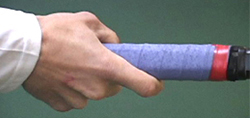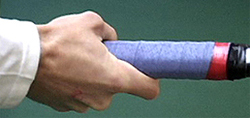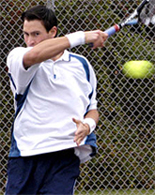
Common Pitfalls in
| |||||||||||||||||||||||||||||||
What are the pitfalls in building the Spanish forehand? |
In the previous articles in this series, we've looked at the technical characteristics of the modern Spanish forehand. (Click Here). We've also looked at a range of innovative drills I have developed based on my study with some of the greatest coaches in Spain.
These have included Spanish hand fed ball drills that are becoming increasingly popular with high performance coaches worldwide (Click Here), as well a series of unique racket fed and power building drills (Click Here).
The goal of this series has been to help players at all levels develop not only sound technique, but world class racket speed. This is what makes the difference in developing a forehand weapon that is capable of both high velocity and heavy spin.
Now in this final article, I want to talk about what I consider to be the common problems and or pitfalls that coaches and players can encounter in trying to build a heavy forehand weapon.
I don't recommend extreme grips, especially for young players. |
Extreme Western Grip
When Building a Spanish style forehand, a full, under the handle western grip can be counterproductive. You don't see this grip at the pro level. Even players such as Nadal and Novak Djokovic are using some version of a semi-western grip with the hand still at least partially behind the handle.
I believe that, particularly initially, the emphasis should be on a relatively conservative grip. These pictures from the first article again show the range of grips that I consider to be effective, basically from a modified eastern to a strong semi-western. But I also believe that the focus should be on developing whip and racket speed, utilizing the whole kinetic chain of the body and maximizing upper arm, forearm, and hand speed in developing the swing.

|

|
The range of grips I advocate—basically from Roger to Rafa. |
|
Developing Heavy Spin Only
Players and coaches interested in the Spanish style forehand sometimes become overly fascinated with spin. This can be often linked to problems with the extreme grip described above. Under the handle grips can produce amazing spin—but power is a different issue.
Developing heavy spin alone doesn't lead to Spanish style power. |
The modern Spanish forehand is not just about spin. It can be unleashed with power and penetration with minimal spin as well. It can be used while taking the ball early and on the rise.
In the quest for heavy spin, coaches often neglect this ability flatten the ball out ,and hit penetrating hard drives. A modern world-class forehand should be able to produce heavy spin and also have the versatility to rip flatter winners on the rise.
The hinge action of the arm, not the wrist is the key to spin. |
Excessive Emphasis on "Wrist Snap"
As discussed in the first article, I believe the wrist can play a role in some situational shots hit with heavy spin, such as sharp angles, late contact points, and sidespin shots. But the primary spin generating mechanism is the loose hinge action of the forearm.
Coaches who wrongly emphasize using the wrist to generate spin are missing the more important element of the hinge forearm action at the elbow joint. The hinge is usually where players struggle as they attempt to develop spin.
I believe that the focus should be on more hinge action at the elbow joint, not excessive motion or snap at the wrist joint. The wrist should be relatively firm, and usually laid back to a greater or lesser extent as the forearm brushes the ball. When the wrist is too loose, players develop improper technique which hampers control, depth, and can make players more susceptible to injury.
Put another way, topspin comes through the swing path. This is through by a good loop that drops the racket head in the backswing, and then the hinge forearm action. For me, any additional wrist action is a higher level skill that should be addressed, possibly, in the development of more advanced players.
You can't build power at the expense of fundamentals like head position. |
Emphasizing Power Over Fundamentals
Often times, especially with young players, coaches will skip ahead prematurely to the weapon-building approach. This will come at the expense of the shape of the parabolic swing, the footwork and especially the balance of the player. In these instances, the player is often left with a wild—yet powerful—shot.
In addition to racket speed, Spanish coaches are obsessed with footwork, balance, and positioning. I believe that practicing racket speed with sloppy swing technique will ultimately ruin shot accuracy and also place the player at a greater risk of injury.
Although the exercises I have presented are aimed at maximizing racket speed, this is always in conjunction with balance and footwork. For example, if a player does not learn to keep the head still and stable during rotation of the body through the shot, the consistency of the shot will be compromised. The same is true of the balanced landing when players go into the air with one or two feet.
The racket starts back as part of the body turn. |
Taking the Racket Back "Early"
This is the old teaching adage that refuses to die, despite the vast video resources on Tennisplayer.net and elsewhere that demonstrate the relationship between the body turn and the timing of the backswing. In my opinion, traditional coaches can kill racket speed by forcing players to take the racket back too early with independent arm motion. As discussed in the first article, I believe that what I call the hold-rhythm is key to developing maximum whip. (Click Here.)
Beautiful Technique without Power
Many times, players will come to my academy with very nice, fluid modern forehands but not enough heaviness and force behind their shots. I believe weapon building through the exercises described in these articles is critical to take a fluid forehand and make it a serious threat.
The forehand must have vicious, scary racket speed, and generally this must be developed quite systematically, unless the player is a freak with incredible fast-twitch fibers in the arm. Neglecting to develop this aspect of the swing will result in a forehand that can't do any real damage at the high level.
My goal: gorgeous swing shapes with awesome racket speed. |
This is the flip side of the problem of all power and no technique. Nice for a textbook, but not going to win the big trophy. My belief is that players can have it all, gorgeous fluid swing shapes with explosive power and heavy spin.
Stay on the Ground
I know this will sound heretical to some, but I teach all my beginner junior students to learn how to jump--yes jump!—into their shots.
I believe leg drive and dynamic balance can and should be trained from the earliest years. Kids should learn how to activate their calves and quads and sequence the kinetic chain from the ground up.
Equally critically, as we saw in the previous articles, I train the landing after the load/explode sequence, which helps kids learn balance. Some traditional coaches will have a hard time allowing kids to explode off the ground into the air to hit a shot, but this is a crucial developmental step in learning the modern Spanish forehand.
I teach kids how to explode into the air. |
One key in teaching kids to jump with balance is to first set up in position behind the ball. As I always say, "if you are in position you can jump into a shot, but never jump into a shot to gain position."
Lack of Tactical Integration
Players should be introduced to the essential tactics that will become part of their DNA as they learn their new forehand technique. Coaches should try to integrate a tactical framework of how to use this new forehand weapon to accelerate the comprehension of the student and to motivate the student to learn the new techniques.
Students will be more willing to learn a modern forehand if they understand how the forehand will serve them better as a more versatile weapon, This means the ability to create sharper angle shots, playing improved their defense, hitting with more margin when desired, and moving around the backhand to control points.
I teach my students the kick serve along with a modern Spanish forehand and link the tactical discussion to both shots. The kick serve often sets up the big Spanish forehand at the top junior and professional level. (For my series on developing this serve, Click Here.)
The player hits a kick serve, lands on balance and then finishes with a short forehand. |
I like to introduce these tactical/technical connections as early as possible in a player's development. For example, all of my students learn a big, angled kick serve. This sets up the classic kick/forehand Spanish combination.
I do a drill where a player hits the kick, lands on balance, then moves forward to finish a short ball, something this serve can produce on a regular basis. Learning a Spanish forehand without learning a big kick serve simply doesn't sense since the player will lack a key shot to set up the new forehand weapon.
Training Only on Fast Courts (and/or with Fast Balls)
It is very difficult to develop racket speed and whip when the courts are super fast and the balls shoot in low and hard. In Spain, they have the great advantage of their beautiful red clay courts, which help players learn tactics more easily, but also contribute to their players developing tremendous whip on their shots.
The clay in Spain is generally very slow and the balls get weighted down with clay and moisture. Thus, the players must learn by necessity to swing like a beast or they simply can't succeed.
Spanish players have the great advantage of red clay. |
It is more difficult to build a Spanish style forehand without clay. I do it in the New York City area where we do not have a lot of clay, but it's not easy. It helps to use slower balls, such as balls that are not brand new, to give players time to step back, and let the ball drop into their strike zone and accelerate.
On the Rise Only
To develop whip and racket speed the Spanish way, particularly with younger players, it is essential to learn to back up and take the ball on the fall. Learning only to take the ball early will kill the development of a heavy topspin ball.
In previous articles I have written how important it is to develop an attacking on-the-rise component in every player's game. (Click Here.) But the other half of complete development is the ability to step back and let the ball drop into the strike zone.
In Spain this is called "receiving the ball." This allows the incoming speed and spin to decrease, allowing players to whip upward to generate the big spin shot. A player who is forced to take every ball early will not be able to truly get under the ball, load and generate heavy spin. This is why I believe that on the rise attack and heavy spin should be taught as separate aspects.
To develop racket speed and spin it's essential to learn to receive the ball. |
Conclusion
Rafa has revolutionized the modern forehand with his power, racket speed, and versatility. I believe all coaches and players who are interested in building a Spanish forehand should experiment with the advice and the exercises I have provided in this series to help them do the same.
Most importantly, I hope you the reader will be creative and use the ideas from these articles as inspiration to create your own drills to help yourself or your students develop both better forehand technique and maximum racket speed.
Through experimentation and creativity, coaches and players may be lucky enough to stumble upon the next generation forehand evolution. Or more likely, some next generation champion will show us all the way.
But racket speed and power development will always be essential to building a world-class forehand shot. Having traveled widely in the coaching world, I believe the Spanish have the best system to maximize these two critical components of a world-class forehand.
 |
Chris Lewit, USTA High Performance Coach and author of The Tennis Technique Bible, is an innovative leader in the high performance coaching community. Chris played #1 for Cornell University and competed on the professional Satellite and Futures Tours. Chris has developed many international and national level junior players, including several top 10 USTA nationally ranked players. This article is excerpted from Chris's current book project, The Secrets of Spanish Tennis. Please visit www.chrislewit.com for more info about Chris, his books, or his academy in New York. |
|
Contact Tennisplayer directly: jyandell@tennisplayer.net
Copyright Tennisplayer 2005. All Rights Reserved.

